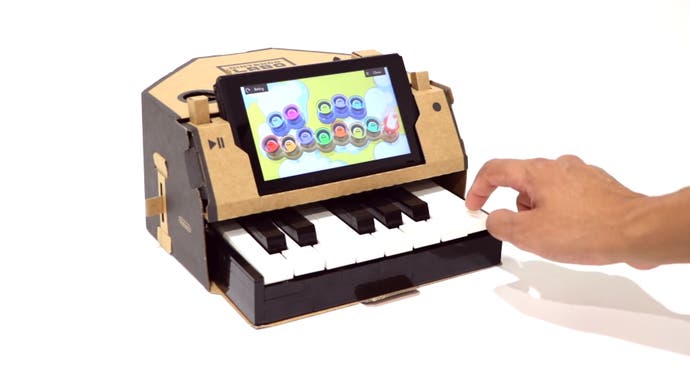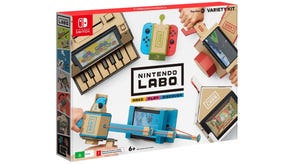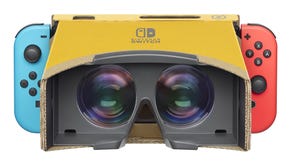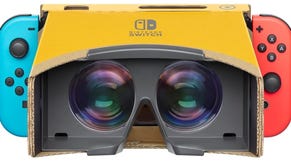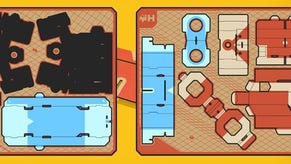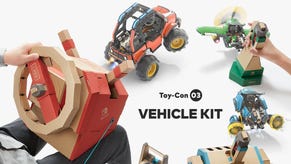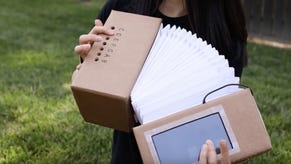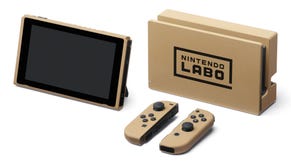Moments of 2018: Labo makes magic from cardboard
Board games.
A box full of cardboard doesn't seem brilliant- not for £50, anyway. You could spend a fraction of that elsewhere and come away with enough cardboard to build a fortress. But Nintendo Labo is brilliant - deceptively so - and most people don't know the half of it.
The magic starts with the box itself. When you open it up, it's packed with stuff: game case, paraphernalia like little ropes and stickers, and a thick stack of unblemished, neatly colour-coded cardboard templates smelling of wholesomeness and begging to have their shapes popped from them. There's so much it's actually a bit daunting, especially if you're young, or with a young one.
But Labo isn't like Lego where you leaf through an inanimate booklet you'll inexplicably lose anyway. Labo comes to life on your telly or Switch screen in a jaunty and easily understandable way. It does nice little Nintendo things like telling you to take a break, or spoons on a bit of encouragement to keep you going towards the end, and it's not intrusive - you could have it on in the background quite happily. Crucially, it makes simple what can be quite complex. You'll be folding a piece over and over and over, enjoying the serene crease and crumple of the cardboard - all while completely unaware how it will become the thing you're making - and then you'll look back down and you've done it.
What's more impressive is how the cardboard creations are designed for use. There are the moving parts you'll mobilise with rubber bands, parts you'll double-over for reinforcement, and bits which slot in and out to perform functions you can only guess at. You can feel the engineering, the countless hours Nintendo's team has spent not only making a toy work but making it robust enough to sustain repeated use, and to be put together by anyone.
As you build, your appreciation deepens, and slowly - pop, slot and lock - you will have a discernible thing in front of you (and a load of mess, but it's OK, it's craft mess, it's debris to prove you made it). And you know how it works. Well, almost. You know how the cardboard structure came together, but you don't really know what will happen when you slot the joy-cons, or the Switch screen, in. When you do, it's like the sprinkle of fairy dust: your toy magically springs to life.
I made a mistake with Labo. I assumed other people would feel the same way about the toys as I did, and my son did, having made them together. So I took them away from my home and into work, figuring they belonged there anyway. I lugged a robot backpack; mini-motorbike handlebars; mini fishing-rod; mini-house; and incredible mini-piano into work for all to admire. I couldn't wait to see their faces - "Wait, you made that?!"
People came to browse, some played, and fewer still tinkered, but then they left. They didn't care, I realised - they didn't care because they hadn't invested in the making. They couldn't see past the cardboard toy - they couldn't see each fold and slot, each revelation as the build came together, and couldn't see the delight on our faces as we played for the first time. So the toys fell silent, unused and ignored, until one day I dismantled them for recycling. Alas! Cardboard magical even in death.
What really needles me is how I took those toys away from my son. I took them away just as he was reaching the third and other overlooked stage of Labo: experimentation. He'd made and played with the toys according to the rules and now he was looking at other ways to see what they could do. He was so invested in them because of what came before and he wasn't ready to let them go. He was branching into engineering and programming. It's the Holy Grail for a parent to see this kind of inspired nosing around, and he was choosing to do it - I wasn't pushing him. But then I took it away.
How long did Labo ultimately last me - last us? About two weeks (although I was pushing it hard for review). How long would it have lasted us if I hadn't abruptly ruined everything? Probably another week or two. Is that enough? I see and hear that question a lot. But enough for what - to make powerful memories from shared experiences? To see a young brain ignited with curiosity? To lose oneself in the simple pleasures of making, and to feel warm satisfaction of a job well done? Yes, it is.
Want to know how we decided Eurogamer's best game of 2018? Give our podcast a listen through iTunes, Spotify, RSS, and SoundCloud:
